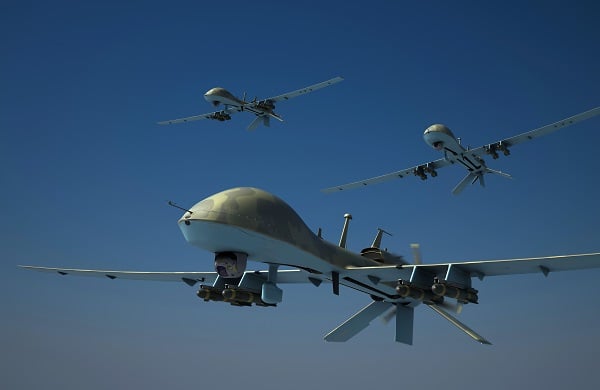Hezbollah is using such attacks to practice its ability to fire combinations of UAVs, rockets, and anti-tank missiles to overcome air defenses and hit targets.
By Yaakov Lappin, JNS
Hezbollah’s increased deployment of unmanned aerial vehicles into northern Israeli airspace is designed to expose vulnerabilities in the Jewish state’s air defense systems.
The Iranian-backed terror army has been leveraging its proximity to Israel to study and search for loopholes, flying UAVs at low altitudes and launching them from southern Lebanese valleys to evade Israeli detection and interception systems, primarily Iron Dome.
Hezbollah has also systematically practiced its ability to locate and target Israeli air defense systems.
This latter tactic appears to have been illustrated on Aug. 5, when Hezbollah released a video claiming to have struck a sensor component of an Israeli counter-drone system, possibly with an explosive quadcopter.
Cmdr. (res.) Eyal Pinko, a researcher at the Begin-Sadat Center for Strategic Studies at Bar-Ilan University in Ramat Gan and an expert in intelligence, cyber and national security, told JNS that Hezbollah, along with Iran and Hamas, has been systematically studying and adapting to Israeli air defense capabilities over the years.
“For many years, Hezbollah, Iran and Hamas have been learning about Israeli air defense capabilities and improving their own capabilities,” said Pinko, who served as a senior officer in the Israeli Naval Intelligence Division, as well as in an additional intelligence organization.
“This is true for their ballistic missile systems, cruise missiles and UAVs. They fire salvos and test how we respond. They know how to fire at different areas and observe our reactions,” he said.
Pinko pointed out that the ongoing conflict has seen Hezbollah intensify these tactics. He added that despite continuous upgrades to Israeli air defense systems, “There’s always a race between defense and offense, and the winner is whoever upgrades first.”
In addition to Iron Dome to take on the threat of UAVs from Lebanon, the Rafael Advanced Defense Systems-made Iron Beam laser interception cannon is due to become operational in the coming months.
There have been reports that the IDF is also testing radar-guided Vulcan cannons, with Defense News writing on May 29 that the M61 Vulcan cannon, which can fire some 6,000 rounds per minute and be mounted on top of armored personnel carriers, has been the subject of the tests.
The evolving threat posed by Hezbollah’s UAVs underscores the challenges Israel faces in maintaining its longstanding air superiority.
The limitations of Israel’s air superiority
Brig. Gen. (res.) Eran Ortal, a senior research fellow at the Begin-Sadat Center for Strategic Studies (BESA Center) and former commander of the IDF’s Dado Center for Multidisciplinary Military Thinking, co-authored a paper with Brig. Gen. (res.) Ran Kochav, a former commander of the IAF’s Air Defense Array, published on July 22, arguing that the current conflict has highlighted the limitations of Israel’s air superiority, particularly in what they term the “low skies”—the airspace where small, low-altitude UAVs operate.
“The current war and Hezbollah’s drone strikes have demonstrated that Israeli air superiority does not extend to the layer of ‘low skies,’” the paper asserts. “It is evident that the enemy is targeting the air defense systems themselves.”
Ortal and Kochav stress that while the Israeli defense establishment is developing various solutions to this challenge, technological development and procurement alone will not be sufficient.
“The basic assumptions under which air defense evolved have been undermined,” they wrote. “Air defense needs to be reorganized under the understanding that its components will be the enemy’s first targets, and that defending forces on the front line requires different organization, command, control and resources than defending the home front.”
Ortal and Kochav called for the establishment of a new tactical air defense array for the northern front, similar in nature to the older anti-aircraft units that the IDF previously shut down.
“Gradually, a new-old layer of threat has developed: unmanned aerial vehicles (UAVs) that are small, have low radar signatures, are cheap, and are numerous,” Ortal and Kochav observed.
“The world of drones and various flying devices has completely changed the basic assumption of absolute air superiority.”
While the IAF continues to dominate Middle Eastern skies, “under the nose of the advanced fighter jets, a new aerial layer has been formed—low skies,” they wrote, adding that this is where enemies have found a loophole.
A learning race
Ortal, in a separate paper published on May 27, warned that the ongoing war of attrition in the north is not just a series of tit-for-tat exchanges but also both sides trying to gain an upper hand for a possible decisive conflict.
“The war of attrition in the north is not just a system of response equations. It is also a learning race and preparation for a campaign in which both sides will try to defeat the enemy’s military forces,” he wrote.
Ortal stressed that Hezbollah is using these exchanges to learn about the performance of Israeli air defense systems and to identify weaknesses.
“The most popular target for Hezbollah is the air control base at Meron,” Ortal noted. “This critical facility, including for the air defense array, has been attacked dozens of times using a variety of methods.
(At 3,950 feet (1,204 meters) above sea level, Mount Meron in the Upper Galilee is the highest peak within the Green Line.)
“The IDF focuses on the limited damage and the relative success of intercepting rockets and protecting the facility, but the enemy may see this as an ongoing experiment to test Iron Dome’s performance envelope,” Ortal said.
Hezbollah is also using such attacks to practice its ability to fire combinations of UAVs, rockets and anti-tank missiles to overcome air defenses and hit targets.
The Lebanese terrorist group’s use of UAVs is not just about gathering intelligence or striking isolated targets; it is part of a broader strategy to test and overwhelm Israeli air defenses, Ortal warned.





